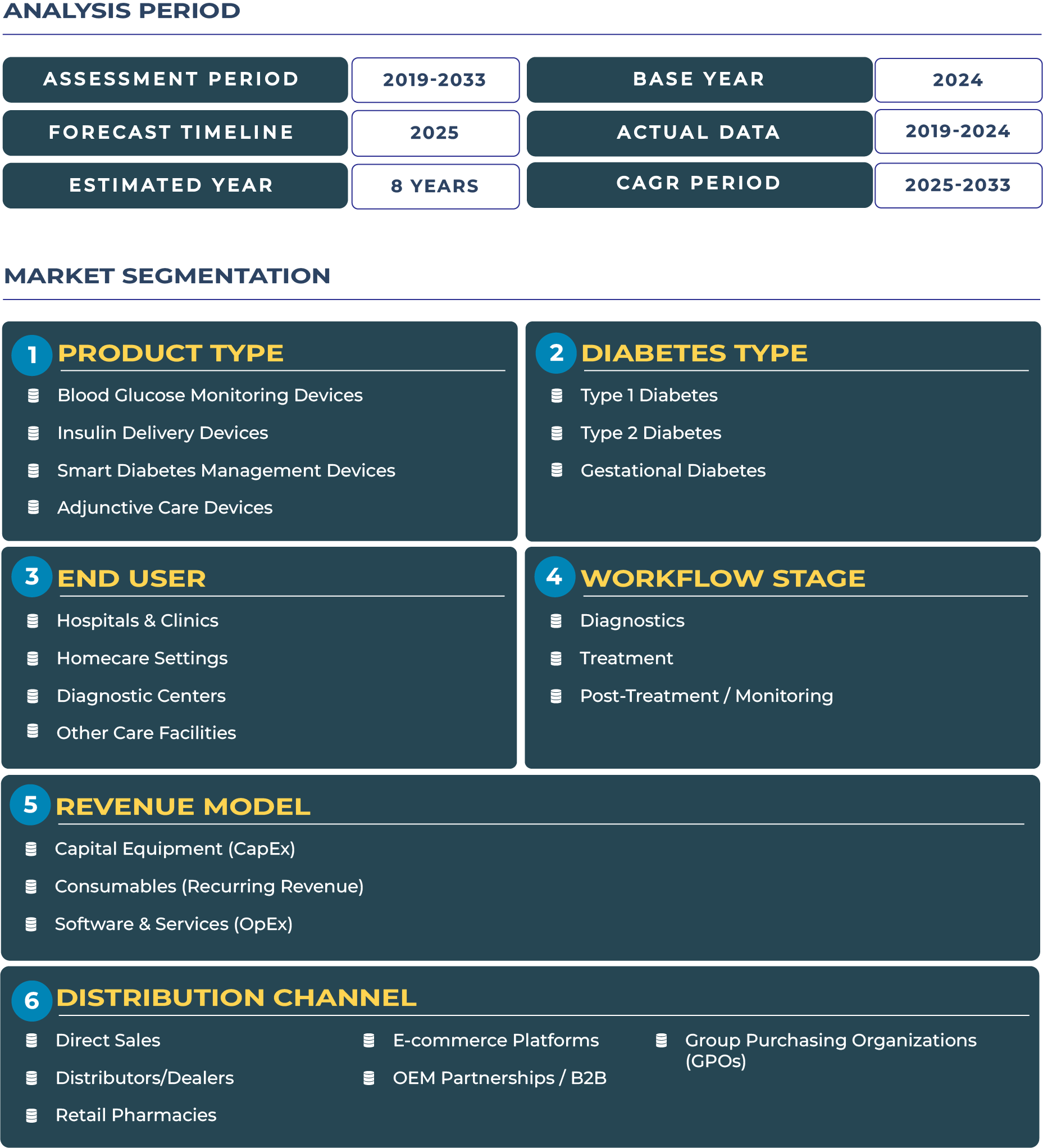Report Format:
![]()
![]() |
Pages: 110+
|
Pages: 110+
Aligning Diabetes Care Devices Launches with National Health Events in Qatar
Timing product launches to coincide with national health initiatives has become a central strategy in Qatar diabetes care devices market. The country often aligns procurement decisions with milestone events, such as World Diabetes Day and bespoke hospital pilots, to ensure maximum visibility and adoption. This alignment underscores the significance of timing in driving procurement, where medical technology introductions gain faster traction when linked to national health campaigns. The diabetes care devices industry in Qatar is thus not only shaped by demand for advanced monitoring and delivery systems but also by its ability to leverage national health events and public sector programs.
According to DataCube Research, the Qatar Diabetes Care Devices Market is projected to expand from USD 27.5 million in 2025 to USD 37.4 million by 2033, registering a CAGR of 3.9%. This growth trajectory is supported by Qatar’s rising healthcare expenditure, strong government-backed health campaigns, and the introduction of connected devices that cater to both patient convenience and clinical efficiency. The market’s steady pace reflects how well-positioned manufacturers and healthcare providers are to align with Qatar’s evolving public health agenda.
Unlocking Growth through Event-Driven Procurement and Strong Healthcare Investment
The outlook for the diabetes care devices sector in Qatar is shaped by consistent healthcare funding, demographic trends, and the government’s commitment to public health initiatives. Qatar has one of the highest per-capita health expenditures in the Gulf Cooperation Council (GCC), which creates fertile ground for adoption of advanced blood glucose monitoring systems, insulin delivery technologies, and connected management platforms. A significant portion of procurement is driven by Qatar’s Ministry of Public Health, which integrates device adoption into its broader strategies for managing non-communicable diseases. The nation’s growing prevalence of diabetes—estimated at nearly 17% of adults—further justifies steady investments in both basic and smart care solutions.
Beyond domestic demand, Qatar’s economic stability and its insulation from regional volatility enable steady procurement cycles. While global conflicts and pandemic-related supply chain disruptions have created challenges elsewhere, Qatar’s centralized healthcare procurement system has allowed relatively smooth access to critical diabetes care devices. The market outlook therefore emphasizes resilience, with technology adoption paced by national campaigns and structured tenders. The projected CAGR of 3.9% reflects a sector that, while not experiencing explosive growth, is steadily advancing with consistent backing from public-private partnerships and ongoing healthcare modernization efforts.
Drivers and Restraints: Evaluating the Key Growth Catalysts and Bottlenecks
High Healthcare Spending and Public-Private Collaboration Driving Device Adoption
The diabetes care devices landscape in Qatar benefits significantly from the nation’s high per-capita healthcare expenditure. Strong public and private sector partnerships, exemplified by joint projects between government hospitals and private device providers, are expanding access to modern insulin pumps, continuous glucose monitors (CGMs), and adjunctive care solutions. High awareness campaigns launched through entities such as the Qatar Diabetes Association further stimulate demand by encouraging early diagnosis and treatment. The focus on prevention and patient education increases the uptake of monitoring devices and drives the wider adoption of connected solutions.
Event-Driven Procurement Cycles and Limited Scale Restraining Market Expansion
While growth drivers are evident, the diabetes care devices industry in Qatar is restrained by certain structural challenges. Procurement often aligns with national health days or hospital pilot projects, leading to irregular purchasing cycles that hinder continuous adoption. Furthermore, the country’s relatively small population limits the scalability of device demand compared to regional peers such as Saudi Arabia or the UAE. Pricing pressures, particularly for advanced insulin delivery systems, also act as barriers for wider penetration among private healthcare providers and patients outside of state-subsidized programs. These factors collectively slow down the otherwise favorable expansion path of the sector.
Trends and Opportunities: Mapping the Strategic Shifts in Qatar diabetes care devices Ecosystem
Bespoke Public Hospital Projects Creating Tailored Pathways for Device Integration
A defining trend in Qatar diabetes care devices market is the move toward bespoke hospital projects that integrate advanced CGM and insulin delivery systems into inpatient and outpatient care. Hospitals in Doha and Al Wakrah are increasingly piloting device rollouts as part of targeted diabetes management programs, which subsequently inform national adoption policies. Such initiatives not only enhance patient outcomes but also build confidence among healthcare practitioners in deploying digital health solutions. The trend toward tailoring devices to local hospital needs signals a strong move toward institutionalized adoption pathways.
Opportunities for Pilot National Programs in Connected and Smart Diabetes Care
The diabetes care devices sector in Qatar presents notable opportunities in expanding pilot national programs that integrate connected devices and digital health platforms. Smart diabetes management devices, which allow for real-time monitoring and data sharing, are increasingly aligned with the nation’s digital health strategy. Government-backed initiatives focusing on electronic health records (EHRs) and telehealth platforms create synergies for connected device integration. This creates fertile ground for international and local players to position themselves as partners in pilot programs that could eventually scale into nationwide standards for diabetes care.
Competitive Landscape: Strategic Positioning of Local and Global Leaders in Qatar diabetes care devices Market
The competitive landscape of the Qatar diabetes care devices sector is shaped by the presence of global leaders such as Medtronic, Abbott, and Roche, alongside active participation from regional distributors. These companies align their strategies with national health initiatives, often timing product launches with events like World Diabetes Day to maximize engagement. For instance, recent partnerships between Medtronic and leading hospitals in Doha in 2024 introduced advanced insulin pump systems during national health events, demonstrating the importance of synchronizing corporate strategy with public health campaigns. Local distributors continue to play a vital role by ensuring timely availability of devices within Qatar’s centralized healthcare system. The industry remains moderately consolidated, with global players holding significant influence while regional distributors focus on channel efficiency and patient support programs.







